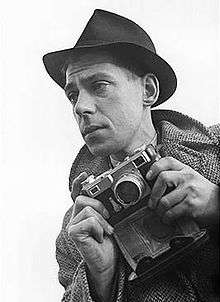Bert Hardy
| Bert Hardy | |
|---|---|
 | |
| Born |
19 May 1913 Blackfriars, London |
| Died |
3 July 1995 (aged 82) Oxted, Surrey |
| Nationality | English |
| Occupation | Documentary photographer |
Bert Hardy (19 May 1913 – 3 July 1995) was a documentary and press photographer known for his work published in the Picture Post magazine between 1941 and 1957.
Life and work
Bert Hardy rose from humble working class origins in Southwark, London. The eldest of seven children, he left school at age 14 to work for a chemist who also processed photos. His first big sale came when he photographed King George V and Queen Mary in a passing carriage, and sold 200 small prints of his best view of the King. Hardy freelanced for The Bicycle magazine, and bought his first small-format Leica 35 mm. He signed on with the General Photographic Agency as a photographer, then founded his own freelance firm Criterion.
In 1941, Hardy was recruited by the editor Tom Hopkinson of the leading picture publication of the 1930s and 1940s, Picture Post. Hardy was self-taught and used a Leica —unconventional gear for press photographers of the era— but went on to become the Post's Chief Photographer, after he earned his first photographer credit for his 1 February 1941 photo-essay about Blitz-stressed fire-fighters.
Hardy served as a war photographer in the Army Film and Photographic Unit (AFPU) from 1942 until 1946: he took part in the D-Day landings in June 1944; covered the liberation of Paris; the allied advance across the Rhine; and was one of the first photographers to enter the liberated Belsen to record the suffering there. He also saved some Russian slaves from a fire set by German police in the city of Osnabrück, before photographing the aftermath.
Near the end of World War II, Hardy went to Asia, where he became Lord Mountbatten's personal photographer. He later went on the cover the Korean War along with journalist James Cameron for Picture Post, reporting on United Nations atrocities at Pusan in 1950, and later and on that war's turning point, the Battle of Inchon, photojournalism for which he won the Missouri Pictures of the Year Award.
Three of Hardy's photos were used in Edward Steichen's famous Family of Man exhibition and book, though not his favourite photo — which shows two street urchins off on a lark in Gorbals — it nevertheless has come to represent Hardy's documentary skill. Hardy himself was photographed many times, including during the war; three very good photo-portraits of him are currently in the Photographs Collection of the National Portrait Gallery.
Having written an article for amateur photographers suggesting that you didn't need an expensive camera to take good pictures, Hardy staged a carefully posed photograph of two young women sitting on railings above a breezy Blackpool promenade using a Box Brownie in 1951, a photograph which has since become an iconic image of post-war Britain.[1]
Just before Picture Post closed, Hardy took 15 photos of the Queen's entrance at the Paris Opera on 8 April 1957, which were assembled as a photo-montage by the magazine's technicians. It was one of the most challenging photo-montages ever created, because there were a sizeable live crowd, guards, and other dignitaries, in front of his camera. After leaving Picture Post Hardy became one of the most successful advertising photographers until his retirement in 1964 to his farm in Oxted.
His second wife, Sheila, was a photo researcher for Picture Post and still holds the copyright to his private collection of photos; Getty Images holds the copyright to his Picture Post works.
A memorial plaque honouring him is in the journalists' church, St Bride's, Fleet Street, London.
In October 2008, London Borough of Southwark unveiled a Blue Plaque on Bert Hardy's family home at The Priory, Webber Street, Southwark. The plaque was erected following a popular vote. [2]
Bibliography
- Bert Hardy. Down the Bay: Picture Post, Humanist Photography and Images of 1950s Cardiff (2003)
- Bert Hardy. Bert Hardy: My Life (The Gordon Fraser Gallery Ltd, London, 1985)
References
- ↑ Mystery of the Blackpool Belles finally rings true. Telegraph. Retrieved on 28 July 2016.
- ↑ John Prendergast (17 October 2008) BIG FAMILY TURNOUT FOR THE SNAPPER WHO DOCUMENTED THE ELEPHANT. southwarkweekender.co.uk
Sources
- Operatic Entrance, by David J. Marcou, Smithsonian, March 2007, pp. 16–18.
- Sue Davies. (1995-07-05). Obituary: Bert Hardy. The Independent. Retrieved 2008-04-04.
- Ben Campkin. Down and Out in London? Photography and the Politics of Representing 'Life in the Elephant', 1948 and 2005" in Swenarton, M., Troiani, T., Webster, H. (ed.) "The Politics of Making" (AHRA Critiques: Critical Studies in Architectural Humanities series. Abingdon and New York: Routledge, 2007), pp. 230–243. ISBN 978-0-415-43101-9.
- Graham Harrison. (2008). Photo Histories: The Life and Times of Albert Hardy (1913–1995). Retrieved 2008-06-16.
External links
- Photograph of the two young women sitting on railings above the Blackpool promenade
- Selection of Bert Hardy's images of life in London in 1948.
- "The Cockney Eye: Bert Hardy(1913–1995), A Neo-Dickensian 'Picture Post' Hero", the online version (La Crosse History Unbound website) of paperback biography about Bert Hardy of 50,000+ words including full-text, endnotes, and photo-illustrations, authored by David Joseph Marcou, and first published by DigiCOPY of La Crosse, WI, in Feb. 2013.